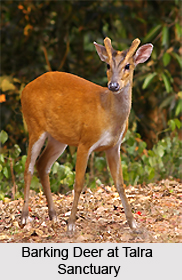 Talra Wildlife Sanctuary is a portion of the two tehsils which belong to Shimla in the northern Indian state of Himachal Pradesh, which are known as Jubbal and Chopal. This wildlife reserve is based at a distance of nearly 92 kilometres away from the region of Shimla and occupies an area of about 40.49 square kilometres. This Indian sanctuary is based on the eastern part of Shimla and is quite close to the borders of the state of Uttarakhand. The elevation of this wildlife sanctuary measures about 1, 500 metres to 3, 324 metres and was proclaimed a wildlife sanctuary in the year 1962. It was again officially notified as a sanctuary during 1974, according to the Wildlife Protection Act of 1972. The sanctuary used to be a favourite hunting ground for hunters during the British era and remained so even post-independence.
Talra Wildlife Sanctuary is a portion of the two tehsils which belong to Shimla in the northern Indian state of Himachal Pradesh, which are known as Jubbal and Chopal. This wildlife reserve is based at a distance of nearly 92 kilometres away from the region of Shimla and occupies an area of about 40.49 square kilometres. This Indian sanctuary is based on the eastern part of Shimla and is quite close to the borders of the state of Uttarakhand. The elevation of this wildlife sanctuary measures about 1, 500 metres to 3, 324 metres and was proclaimed a wildlife sanctuary in the year 1962. It was again officially notified as a sanctuary during 1974, according to the Wildlife Protection Act of 1972. The sanctuary used to be a favourite hunting ground for hunters during the British era and remained so even post-independence.
Flora of Talra Wildlife Sanctuary
Talra Wildlife Sanctuary is home to dense forests, particularly those indigenous to the Western Lower Himalayas. The other types of forests present here include Fir Forests, Oak Forest which are more commonly found in the Upper Western Himalayan Mountain ranges. These forests create a magnificent green corridor in the sanctuary grounds which attract innumerable nature lovers to this part of the country.
Fauna of Talra Wildlife Sanctuary
Himalayan Black Bear, Panther, Barking Deer, Leopard, Asiatic Black Bear, Musk Deer, Goral, Common Langur and Pheasants are a few of the exotic species of wildlife which are local to Talra Wildlife Sanctuary.
This wildlife sanctuary experiences a temperature of about 28 degree Celsius and during winter months it drops down to about four degree Celsius. Therefore the ideal time to pay visit to this region is between the months of November and December. Till March, snowfall covers the area of this sanctuary. The closest airport of this sanctuary is based in Shimla.
This article is a stub. You can enrich by adding more information to it. Send your Write Up to content@indianetzone.com



















